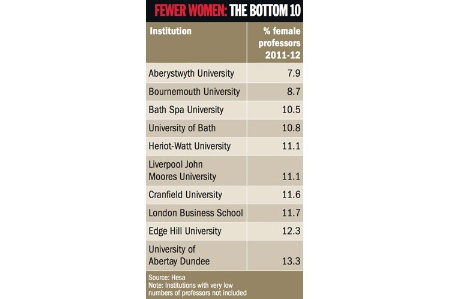Source: Alamy
Minority report: women make up 45 per cent of non-professorial academics but it is men who still dominate at professor level
Universities’ efforts to address gender inequality have been criticised in light of figures showing that just one in 10 professors is a woman at some institutions.
Overall, around one in five professors in the UK is female, but statistics obtained by Times Higher Education show that several universities are falling well short of that low benchmark.
There were just six women among 77 full-time equivalent professors at Aberystwyth University (7.9 per cent) in 2011-12, according to data provided by the Higher Education Statistics Agency.
At Bournemouth University the figure was just three out of 30 professors (8.7 per cent), while at the University of Bath it was 18 out of 163 (10.8 per cent), the Hesa figures show.
At Imperial College London the proportion was 14.1 per cent in 2011-12, at the University of Liverpool it was 14.7 per cent and at the University of Cambridge it was 15.6 per cent.
Despite the prevalence of men in the professoriate, many universities have managed to achieve near gender parity in other academic grades, with women making up 45.1 per cent of non-professorial academics.
But it is women’s lack of progression through the academic ranks that must be addressed, said Louise Morley, director of the Centre for Higher Education and Equity Research at the University of Sussex.
“Universities need to be held to account for their low numbers of senior women,” said Professor Morley, who suggested that universities should be barred from research funding unless they can prove they are supporting female academics’ careers.
“Some type of leverage is required as it does not appear that universities will initiate [change] themselves,” she said.
Professor Morley also suggested that it should be mandatory for institutions to sign up to the UK Athena SWAN project, which promotes women in science, so that “gender [is] factored into all strategic planning and processes”.
Publishing comparative data (the THE’s table is the first breakdown by institution of such information) could also force universities to address the professorial gender gap, she added.
“These statistics need to be in the public domain,” she said.

Specialist equality
Research-intensive universities tend to have lower numbers of female professors, our data suggest.
Only six of the 24 Russell Group universities have higher than average female representation among the professoriate.
Meanwhile, universities specialising in arts and humanities subjects tend to perform better.
The University of the Arts London, the Courtauld Institute of Art, the University of Roehampton and the Institute of Education, University of London are the only institutions out of 129 surveyed where female professors form the majority.
Nicola Woodroofe, professor of neuroimmunology at Sheffield Hallam University, who runs a mentoring programme for female academics, said that the lack of female professors was particularly apparent in science-based subjects.
However, women in all subjects needed more support when applying for promotion, Professor Woodroofe said. They should also be more confident in applying for professorial posts – a trait that partly explained the low number of female professors, she suggested.
“Men often feel that if they tick a few of the boxes they will take a chance and apply, but women want to be certain they will be successful,” she said.
“It means they don’t always apply when they could and miss out on valuable feedback that could help future applications.”
Commenting on the data, Aberystwyth, whose vice-chancellor April McMahon was one of the six female professors recorded by the data, said that the figure this year is 12 per cent, with half of its eight-strong executive team being women.
The number of female professors at Bournemouth has also increased to nine since the data were collected, the university said, taking it close to the sector average. It is a member of Athena SWAN and has established a Women’s Academic Network, it added.
Bath said that half of its staff are women, including 50 per cent of its senior management team, including its vice-chancellor, Dame Glynis Breakwell.
The university added that it was working to increase the proportion of professors who are female.
For example, if a professorial shortlist does not contain a female candidate, the chair of the selection panel must be satisfied that steps have been taken to encourage female candidates to apply, Bath said.
Register to continue
Why register?
- Registration is free and only takes a moment
- Once registered, you can read 3 articles a month
- Sign up for our newsletter
Subscribe
Or subscribe for unlimited access to:
- Unlimited access to news, views, insights & reviews
- Digital editions
- Digital access to THE’s university and college rankings analysis
Already registered or a current subscriber? Login




